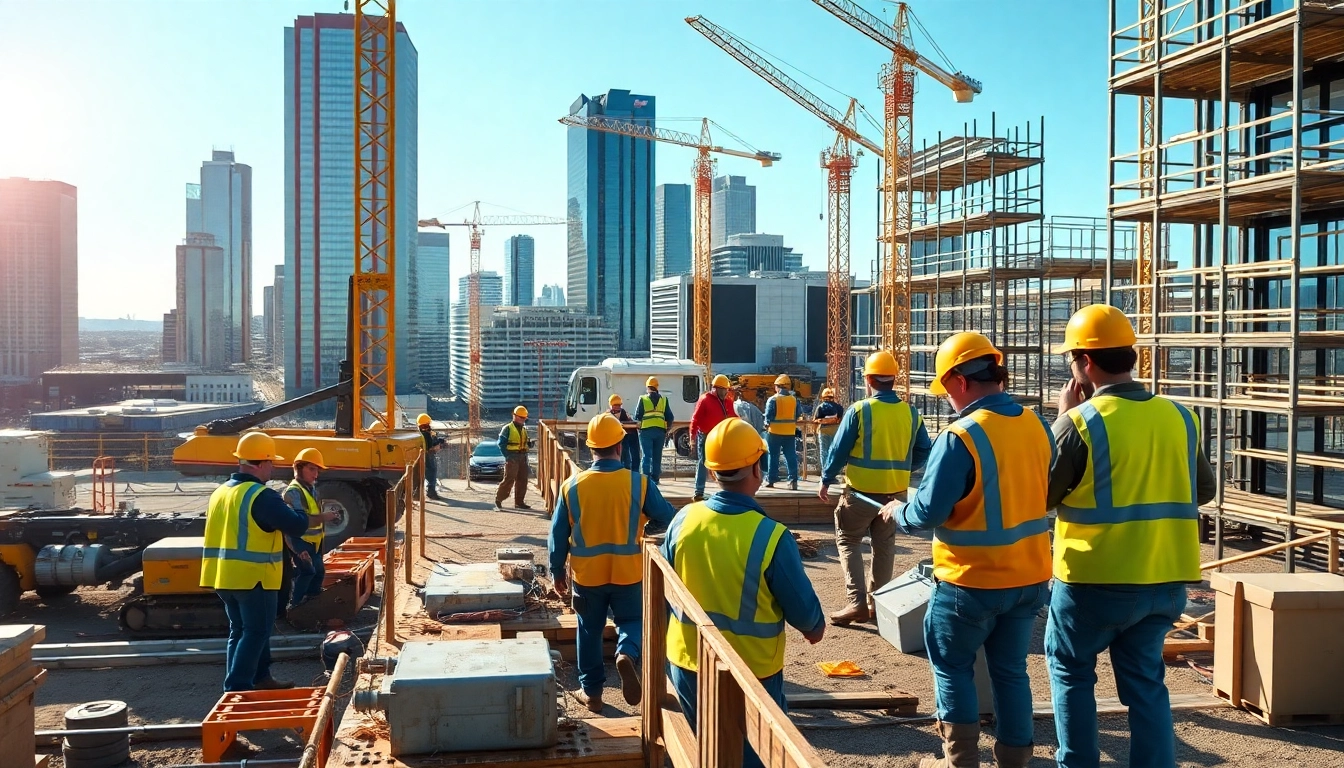
Enhancing Urban Development: Insights into Austin Construction Trends and Best Practices
Understanding the Austin Construction Landscape
Austin, Texas, is a vibrant city that has been undergoing remarkable growth and transformation over the last few decades. Its construction landscape plays a pivotal role in shaping the future of urban development, driven by a booming population and an ever-evolving economy. With the proliferation of opportunities in austin construction, individuals and organizations alike are keen on understanding the nuances of this dynamic sector. This article explores the evolution of construction practices in Austin, identifies key players, and examines current trends that are impacting urban development.
The Evolution of Construction Practices in Austin
The construction industry in Austin has seen significant evolution since the early days of the state capital’s founding. Initially characterized by single-family homes and low-rise buildings, the landscape has transformed into a diverse array of multi-family housing, skyscrapers, and commercial establishments. The growth of the technology sector, coupled with Austin’s cultural appeal, has resulted in a construction boom that continues to reshape the city’s skyline.
In the 20th century, the focus was primarily on accommodating a growing population through suburban expansion. However, the turn of the century ushered in a new era of urbanization, fueled by an influx of tech professionals and a demand for mixed-use developments that blend residential and commercial spaces. Today, sustainable building practices, smart technologies, and community-oriented designs are at the forefront of construction trends.
Key Players in the Austin Construction Industry
The Austin construction industry is populated by a mix of local firms and national corporations, all of which contribute to the city’s dynamic growth. Key players range from general contractors and construction management firms to specialized subcontractors in fields such as electrical work, plumbing, and landscaping.
Prominent companies such as SpawGlass, Turner Construction, and Webber are among the leading firms making significant contributions to major projects across the city. These companies often collaborate with local architects and engineers, ensuring that each project reflects Austin’s unique architectural style and community needs.
Additionally, government entities and non-profit organizations such as the Austin Housing Authority play a crucial role in influencing the construction landscape through initiatives aimed at affordable housing and community development.
Current Trends Impacting Austin’s Urban Development
As Austin continues to grow, several key trends are shaping the future of its urban development:
- Smart City Initiatives: Embracing technology to improve infrastructure and streamline processes, Austin is integrating smart city initiatives aimed at enhancing connectivity and sustainability.
- Green Building and Sustainability: There is an increasing focus on eco-friendly construction practices, including energy-efficient designs and the use of sustainable materials, driven by both consumer demand and regulatory pressures.
- Mixed-Use Developments: Projects that combine residential, commercial, and recreational spaces are gaining popularity as cities aim to create vibrant, walkable neighborhoods.
- Affordable Housing Solutions: With rising housing costs, developers are exploring innovative solutions to provide affordable housing options while meeting zoning and regulatory standards.
Common Challenges in Austin Construction Projects
While the Austin construction industry presents numerous opportunities, it also faces several challenges that can impact project timelines, costs, and overall success. Below are some of the most common issues encountered in construction projects throughout the city.
Managing Rising Costs in Construction Materials
The construction sector has been grappling with rising costs for materials such as lumber, steel, and concrete, largely due to supply chain disruptions and heightened demand. These cost increases place significant pressure on project budgets and can lead to delays if not managed effectively. To mitigate the impact of these rising costs, contractors and developers should consider the following strategies:
- Bulk purchasing agreements to secure lower prices.
- Exploring alternative materials that provide the same structural integrity at a lower cost.
- Effective project scheduling to minimize delays and associated costs.
Navigating Permits and Regulations
Austin’s regulatory environment presents challenges for builders and developers, who must navigate a complex landscape of permits and zoning laws. Variances and building codes can differ greatly between neighborhoods, making it imperative for contractors to be proficient in local regulations. To effectively manage this challenge, construction teams should prioritize:
- Staying informed about changes to zoning laws and permitting processes.
- Engaging with local government officials early in the planning process for smoother approvals.
- Investing in training for project managers in regulatory compliance to avoid costly setbacks.
Addressing Labor Shortages and Skills Gaps
The labor market in Austin is experiencing shortages, significantly impacting construction timelines and costs. Skilled labor is in high demand as experienced workers retire or leave the industry without enough newcomers to fill the void. To combat labor shortages, Austin construction firms can:
- Collaborate with local trade schools and educational institutions to create apprenticeship programs.
- Offer competitive wages and benefits to attract skilled workers.
- Implement training programs for entry-level workers, focusing on developing in-demand skills.
Best Practices for Successful Construction Projects
To secure successful outcomes in construction projects, firms must employ best practices that address challenges while promoting quality and efficiency. Here are several essential practices for success in the Austin construction arena.
Implementing Sustainable Building Methods
Sustainability is no longer optional in construction; it has become a demand from consumers and regulators alike. Implementing sustainable building methods not only enhances a project’s marketability but can also lead to long-term cost savings. Builders should consider incorporating the following practices:
- Using energy-efficient materials and systems to reduce operational costs.
- Designing buildings with natural lighting and ventilation to enhance occupant comfort.
- Incorporating green roofs and permeable pavements to improve stormwater management.
Leveraging Technology in Construction Management
Technology has the potential to revolutionize construction management, improving efficiency and communication across the project lifecycle. Construction firms can benefit from:
- Project management software that enhances collaboration and tracking.
- 3D modeling and Building Information Modeling (BIM) for better visualization and planning.
- Drones for site surveying and progress monitoring, ultimately saving time and resources.
Ensuring Safety Compliance on Job Sites
Safety should always be a priority on construction sites, not only to protect workers but also to comply with local and federal regulations. Best practices for maintaining safety include:
- Regular safety training sessions for all workers, keeping them informed about potential hazards.
- Implementing strict personal protective equipment (PPE) policies and ensuring compliance.
- Conducting regular safety audits to identify and rectify potential issues before they lead to accidents.
Case Studies: Successful Austin Construction Projects
Examining successful construction projects can provide insights into practical applications of best practices within the Austin landscape. Here are three exemplary case studies that showcase innovative approaches, community engagement, and effective execution.
Residential Developments and Community Engagement
The redevelopment of the Travis Heights neighborhood exemplifies how community engagement can lead to successful residential development. The project involved significant collaboration with residents to ensure the preservation of the neighborhood’s historical character while introducing modern amenities. Key elements of success included:
- Community workshops to gather input and address concerns.
- Incorporating green spaces and public amenities, enhancing overall livability.
- Effective communication throughout the process to maintain transparency and trust.
Commercial Construction Innovations
One standout project in Austin’s commercial construction sphere is the IBM Innovation Center, which features cutting-edge design and energy-efficient technologies. The project aligns with the City of Austin’s sustainability goals and serves as a model for future developments. Innovations included:
- Use of recycled materials and energy-efficient systems to minimize the environmental impact.
- Integration of high-tech workspaces designed to foster collaboration and innovation.
- Public art installations that promote community engagement and cultural expression.
Public Infrastructure Projects and Their Impact
Infrastructure projects such as the Luminations at the Wildflower Center have transformed public spaces and showcased effective community involvement. This project, designed as a seasonal lighting display, managed to incorporate local artists and businesses while improving the visibility of the Wildflower Center as a public venue. It emphasized the importance of:
- Public-private partnerships to fund and execute ambitious projects.
- Engaging local talent and providing opportunities for showcasing Austin’s artistic community.
- Creating event-driven infrastructure that attracts visitors and stimulates the local economy.
Future of Austin Construction: Opportunities and Predictions
Looking ahead, the future of Austin construction is set to be influenced by emerging technologies, regulatory changes, and broader socio-economic shifts. By anticipating these changes, stakeholders can prepare strategically for the evolving landscape.
Emerging Technologies Shaping the Industry
Emerging technologies such as artificial intelligence, virtual reality, and smart materials are poised to redefine the construction industry in Austin. These advancements will enhance efficiency, safety, and quality control throughout the construction process. Builders should remain proactive in:
- Integrating AI tools for predictive analytics to streamline project delivery.
- Utilizing virtual reality for design visualization and client presentations.
- Exploring smart materials that adapt to their environments, enhancing building longevity.
Predicted Growth Areas in Austin Construction
As Austin continues to attract businesses and residents, several key areas are predicted to see significant construction growth:
- Affordable Housing: Greater emphasis on developing low-income housing initiatives to address rising housing costs.
- Transportation Infrastructure: Upgrades and expansions of public transportation networks to accommodate the growing population.
- Tech-Centric Developments: Continued growth in commercial spaces designed for tech companies and startups, fostering innovation.
Community Involvement and Resident Perspectives
Community involvement will be crucial in guiding future construction projects, ensuring that developments not only meet economic needs but also reflect the values and desires of residents. Engaging with local communities through forums, surveys, and collaborative projects can drive better outcomes and foster a sense of ownership and pride in development initiatives.
As the Austin construction industry evolves, staying informed about best practices, embracing challenges, and leveraging opportunities will be essential for all stakeholders. By fostering collaboration and innovation, the city can continue to grow sustainably while enhancing the quality of life for all its residents.
